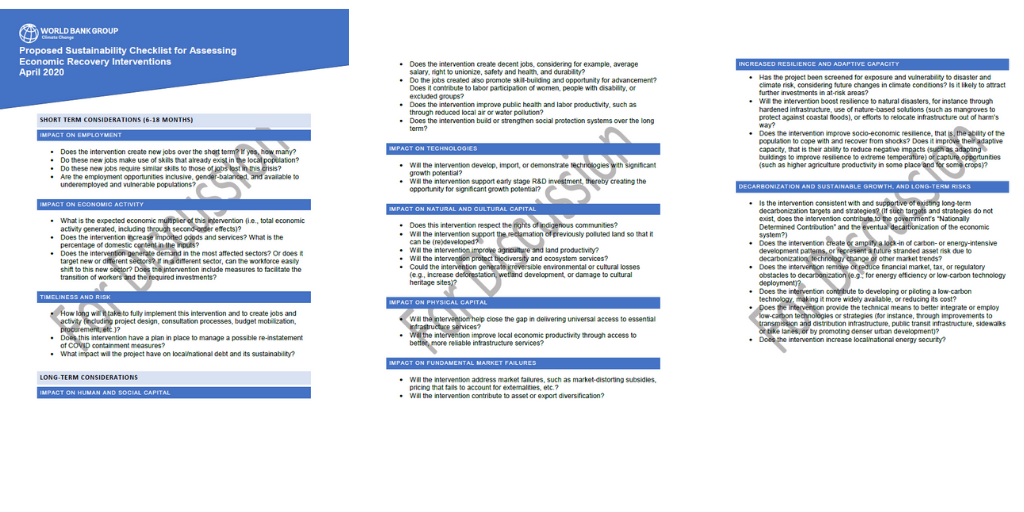 Des enfants à vélo et poursuivant des avions en papier et des cerfs-volants au coucher du soleil
Des enfants à vélo et poursuivant des avions en papier et des cerfs-volants au coucher du soleil
As the coronavirus (COVID-19) pandemic continues, governments and emergency services are focusing on immediate needs: boosting capacity in hospitals, addressing hunger, and protecting firms and families from eviction and bankruptcy. The majority of the funds flowing so far from the World Bank, the IMF, other regional development banks, or central banks seek to provide funds for protective gear at hospitals, stabilize financial institutions, pay companies to provide goods and services to essential workers, or provide direct cash support to households.
In parallel, preliminary work has started in some countries on what the next phase of recovery will look like and the role of strong public action in boosting demand, providing replacement income, and facilitating new investments. In a previous post, we made the point that the recovery phase can help build prosperity and resilience, by contributing to the long-term potential and sustainability of a country’s development pathway. There are encouraging signs from some countries – including China, Germany, and South Korea – that are looking at green elements as part of their recovery.
The choices that governments make to restart their economic engine, including the long-term social, economic, and environmental co-benefits they seek to achieve through their stimulus investments, will be extraordinarily consequential in ensuring that they can build back stronger and better.
A Sustainability Checklist
There are many factors that governments must weigh in putting together their stimulus package: immediate needs, local institutional capacity, market conditions, borrowing headroom, and the legacy of past infrastructure investment decisions. Other criteria to assess for stimulus interventions or investments include their potential for job creation, the lead time involved in breaking ground on the project, whether government funds might help mobilize private finance to further support a project, and the impact on the country’s long-term carbon trajectory.
Factoring in sustainability in the broadest sense means also including longer-term criteria: decarbonization, long-lasting resilience and adaptive capacity, the impact on physical, natural and human capital, among others. To provide this more granular guidance for policymakers, we have developed a draft of a sustainability checklist (to be refined in the coming months) that government ministries can use to assess or rank stimulus proposals.
The checklist essentially raises questions that governments should consider to assess projects and zero in on the most promising. Many governments already have sophisticated decision protocols in place, so this should be seen as complementary guidance, part of our contribution to the ongoing discussions on sustainable recovery pathways.
This checklist draws heavily on analyses of the 2008 economic crisis and, in particular, considers whether complementary policy or institutional changes are required to ensure that projects are shovel-ready. One of the key lessons of the 2008-09 programs was how failure to enact basic market reforms or supportive policies places many green projects at a disadvantage to incumbent technologies or did not have the momentum to disrupt long-standing development approaches.
This checklist can be applied to any list of projects or policies, from cash transfers to direct investments in new infrastructure, that are proposed as part of a stimulus package. It can be applied to existing project lists – for instance from national development plans, transport or water master plans, or Nationally Determined Contributions under the Paris Agreement – or to new proposals created specifically for the post-COVID stimulus. It covers two timescales: short-term needs to deliver as many jobs, income, and economic demand as quickly as possible, and the longer-term need to deliver sustainable growth and prosperity.
Over the short term, there are three main considerations:
- Job creation, looking at the number of jobs created per dollar invested, but also the types of jobs created and who benefits from them, and the match between the skills needed and those available in the local workforce.
- Boost to economic activity, focusing on the economic multiplier each intervention can deliver, the ability of a project to directly replace missing demand, and its impact on import levels or the national trade balance.
- Timeliness and risk, assessing whether the project generates stimulus and employment benefits over the very short term and whether they are durable even in the face of possible re-imposition of local quarantine measures.
Over the longer term, a project must also support countries on three different dimensions:
- Long-term growth potential, looking at its impact on human, natural, and physical capital. For instance, some projects do better at improving human capital, by building the future skills and health of the population, especially if air and water pollution can be reduced, or access to improved drinking water is improved. Others may promote the use of more efficient technologies, provide important public goods like modern energy or sanitation, or address market failures, such as distortive subsidies that are obstacles to long-term growth.
- Resilience to future shocks, with interventions to build capacity for societies and economies to cope with and recover from external shocks, like COVID-19 today, but also other forms of natural disasters and future climate change impacts.
- Decarbonization and sustainable growth trajectory, with actions to support and disseminate green technologies, like grid investments that facilitate the use of renewable energy and electric vehicles, or low-tech options like afforestation and landscape and watershed restoration and management. It will be particularly important to ensure that investments from stimulus packages do not impose large stranded asset costs on the economy in coming decades, for instance because they bet on declining technologies or place projects in high-risk flood zones.
Guiding Policymakers for the Recovery
Governments seeking to apply this framework may wish to use it in two phases.
First, it can be used as a quick cut, “yes-no-maybe” assessment identifying the “worst offenders.” The goal is to ensure that governments don’t invest in projects that are attractive for their stimulus characteristics but detrimental over the long term.
In a second phase, the proposed indicators can help decision makers prioritize among any remaining projects, identifying “best in class” projects that deliver multiple benefits to society.
Policymakers have a lot on their plate right now, and economic recovery plans cannot move faster than efforts addressing the current health crisis. But as governments shift their focus to recovery, the choices that countries make will define what tomorrow looks like and whether we are better able to manage future global crises. This checklist will hopefully make these decisions a bit easier.
Download the Sustainability Checklist for Assessing Economic Recovery Interventions.




Join the Conversation